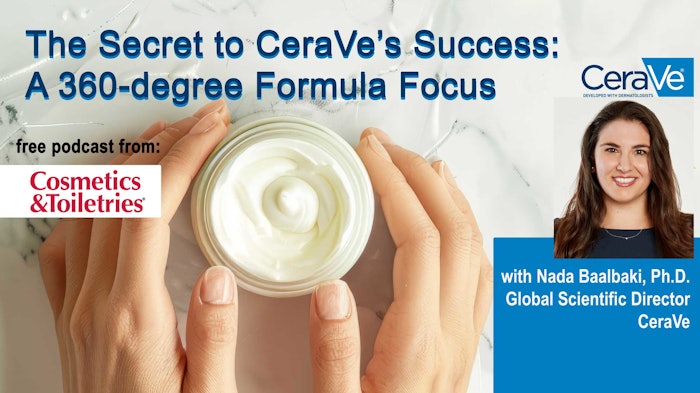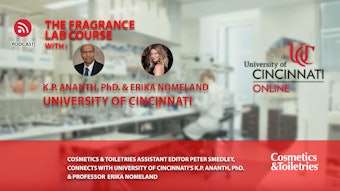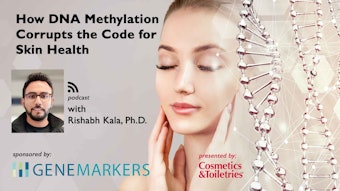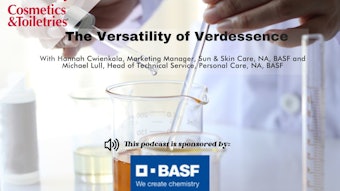
Log in to view the full article
The market for dermocosmetic products was estimated at US $65.7 billion in 2023, according to Global Market Insights, and is projected for a significant 9.5% CAGR from 2024-2032. Per the source, an increasing prevalence of skin conditions is one factor driving this growth. Nada Baalbaki, Ph.D. (NB), global scientific director of CeraVe, might add that consumers' interest in skin health is another major driver. She explains, in this exclusive interview.
See archived: Expert Opinions: Dermocosmetics and Compromised Skin
To feed this consumer hunger for information about skin health and conditions, CeraVe aims to "medu-tain" consumers while also working hand-in-hand with dermatologists to ensure products genuinely address consumer concerns. The brand's relatively simple packaging and dermatological focus have earned it significant market success and surging popularity. But at the core of its success is a 360-degree focus on the formula: looking at not only what's in it, but what's not.
In this interview, Baalbaki describes top skin concerns, formula design, industry trends and movements, and more. Watch now or see the (edited) transcript, below.
Transcribed (Edited) Interview
C&T: What are some of today’s skin care consumers’ top concerns?
NB: Consumers are now focused on skin health and we see that their interest goes beyond products and the benefits they bring. Consumers are also looking to understand their skin, skin’s condition, skin’s needs… It’s a really interesting environment to be in now because the responsibility is not only on brands to bring products that actually work, but also to help bring access to skin health education to consumers through our relationships with our dermatologists. It’s definitely something CeraVe has focused on, this idea of medu-taining consumers – i.e., educating them about skin health-related topics while entertaining them, and doing that in collaboration with our dermatologists.
C&T: How does the CeraVe line of products address consumer concerns?
NB: From the beginning, when we develop our products, we always work with dermatologists to better understand not only what the skin needs, but what their patients need, what the need gaps are and what we can bring to improve the quality of life of their patients. That’s really the foundation of how we develop our products.
We continue to work with our dermatologists throughout the development process to select ingredients, to build the positioning and concept, and to test the formula. We’re working with the dermatologist hand in hand – it’s part of our brand’s DNA – and that really enables us to develop products that, again, not only work but meet the needs of consumers 360 degrees.
C&T: Where do your product ideas come from?
NB: Insights can come from several different directions. We have insight conversations with our dermatologists – and these are dermatologists from around the world – asking them their insights, what their patients need and what the need gaps are in their practice. So it can start that way.
Other times, since we have a close connection with our consumers, we hear from them what their needs are. Then we ask our dermatologists in what ways we, as CeraVe, can meet those needs.
Obviously, L’Oréal Research & Innovation is also constantly researching and innovating. So sometimes we’re bringing innovations to our doctors to understand if those innovations are relevant and how they might better improve the quality of life of their patients. So, the process can start from any facet but it’s something we’re consistently engaging in with our dermatologists.
C&T: From a formulating standpoint, how do you choose ingredients for the desired outcomes you’re looking for?
NB: All of our CeraVe products contain three skin-identical ceramides. That’s something that’s been incorporated from the inception of the brand. We also leverage our multivesicular emulsion, or MVE technology, which is a delivery system for the sustained release of particularly moisturizing ingredients.
When we think about specific formulas and the approach, again, we’re working with our dermatologists – so that’s of course a big consideration when we think about ingredient choices. Really what we’re focusing on is promoting the skin barrier, supporting it, maintaining it, restoring it … so, we’re making ingredient choices to do that.
We’re also avoiding ingredients that may cause a disruption of the skin barrier or an allergic reaction – we’re very diligent in reviewing the ingredient selection with our dermatologists. So again, everything is done hand in hand with them; including ingredient selection.
C&T: What would you say makes CeraVe products so special?
NB: The success of our formulas and of our brand really starts with: they work. When we’re thinking about formula design with our dermatologists, we’re considering everything we’re putting into products from 360 degrees. We’re also thinking about what we’re not including. We think of the formulas as a complete picture when we’re developing them – and, of course, it also comes down to testing to make sure we are delivering on the need we’re trying to address.
C&T: Are there other industry trends with which you align CeraVe products?
NB: We don’t really think of industry “trends” as we develop new products, we work with our dermatologists to understand, again, the needs of patients or consumers and to make sure those needs are what we’re following. Things like sustainability and other topics do come up but it’s more about our responsibility, as a brand, to consumers.
C&T: What makes CeraVe’s derm positioning and simple messaging work for consumers?
NB: There’s not one answer or simple secret behind CeraVe. It’s really the approach of the brand to work with the skin experts, dermatologists, and to focus on the skin barrier and its key role in the health of skin. Marrying these two things really enables our products to meet the needs of consumers and focus very specifically on a given concern – acne, dry skin, etc. – really taking that 360 approach to products.
C&T: Can you hint at any future areas of investigation for the brand?
NB: We are striving to make dermatology accessible to all, so you see us leaning into creating engaging and informative skin barrier health content, and again working with our doctors to do that; it’s this idea of medu-taining them that I brought up before. I think you’re going to continue to see more of that from CeraVe because it’s really important for us to not only deliver efficacious products to our consumers, but also to bring them the skin health information they’re interested in and asking for – and bringing the dermatologists to them to deliver that knowledge.
References
1. Kantar. (2024, Jul 22). The rise of CeraVe: How the brand is winning in the market. Available at https://www.kantar.com/uki/inspiration/analytics/the-rise-of-cerave
2. House of Marketers. (2024, May 30). How CeraVe transformed into Gen Z’s go-to skin care brand [TikTok case study]. Available at https://www.houseofmarketers.com/how-cerave-transformed-gen-z-skincare-brand/










